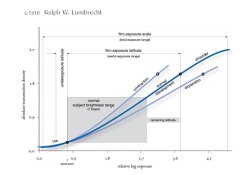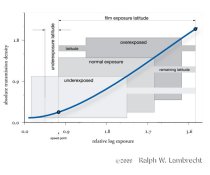B&W print/negative film handles
overexposure very well. That's the key point to understand, for someone new to this.
The best overall dynamic range I have found in the (high end) digital world is about 12 stops. When you compare that to old panatomic x film developed in
POTA... well there
is no comparison. That combination has been shown to provide up to
20 stops of range!!! If I remember correctly, POTA was developed for blast imaging.
But there is of course a lot more to this than dynamic range alone. What you will hear/read film photographers discussing is the toe and the knee of the tone curve (of film and also of photopaper). That tone curve provides a very different look, that many would say is more pleasing than the rather linear response you get from raw digital. In a nutshell, the tones ease into the highlights and the shadows quite gently- not abruptly and with posterization. Digital users must curve their linear scale to get that pleasing look; with film, it's built in. And every film has a different and characteristic 'look' with respect to knee and toe.
But the main point is how b&w print (neg) film handles overexposure. You can record
lots of highlight detail.
P.S. I have an illustrative example from a few years ago that taught me a lot about this issue. I made a big mistake when shooting something on vacation. I had set up an infrared shot, using a deep infrared filter, and the (#87) filter cutoff was so deep that I needed a filter factor of
many stops, 8 or 9 or so stops, as I recall. In other words, I timed the exposure to be 8-9 stops longer than sunny 16. And this was in high noon desert light, near Sedona, Arizona... virtually no clouds!
Problem was... in my haste to get the shot,
I forgot to put on the bloody IR filter when I actually took the shot! So I overexposed by a ridiculous amount. I got my negs back from the lab and they were black to the eye. I mean it: black. Then I held one neg up to a lightbulb and could barely make out a wee bit of detail, so I thought, okay, why not scan it and see if there's anything there before I bleach the hell out of it and try to get something. So scan it I did. And voila... here's what a ~8-9 stop overexposed b&w film shot looks like... actually not half bad! Not pretty but.. hey it's an image.
http://s25.photobucket.com/albums/c76/keithwms/?action=view¤t=tree-yuck-cr.jpg




 Anyway that is a topic for DPUG.
Anyway that is a topic for DPUG.




